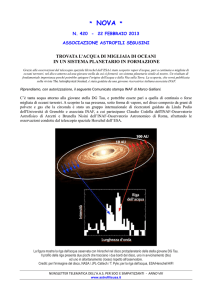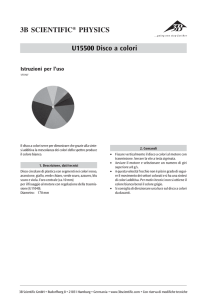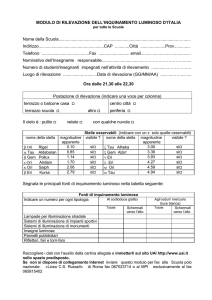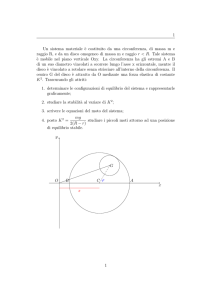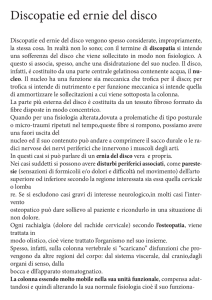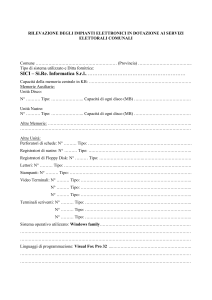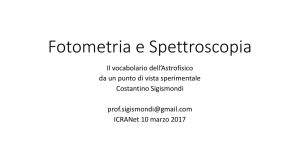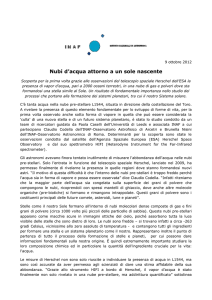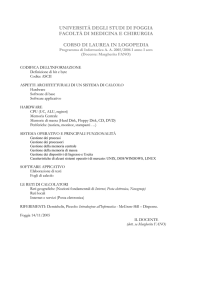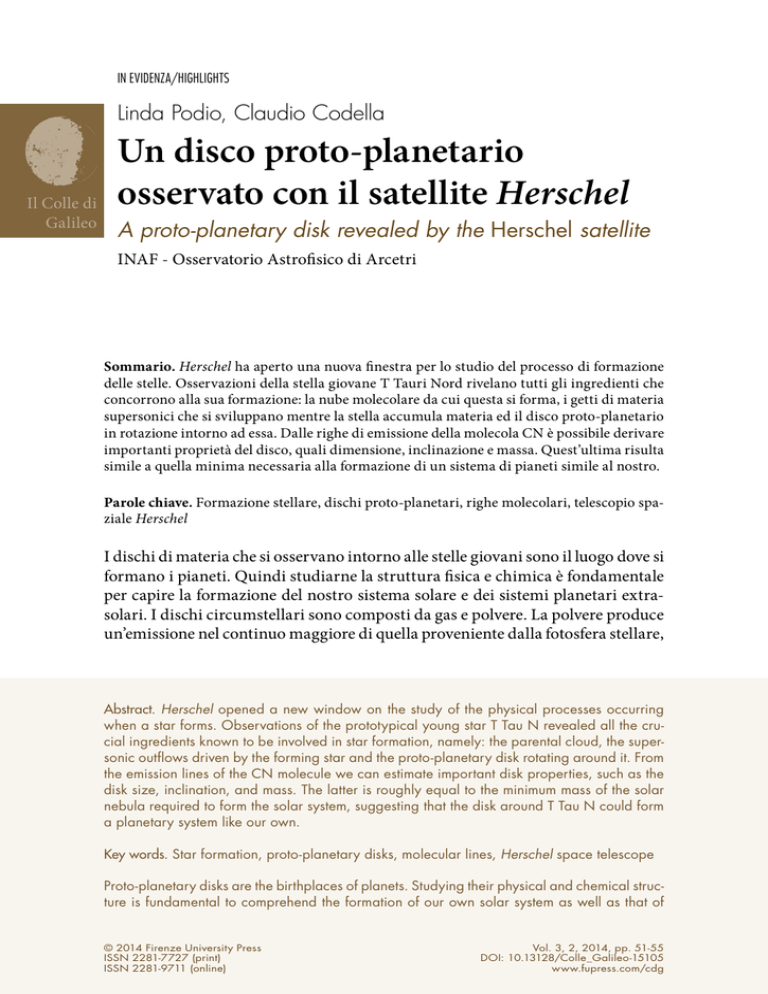
IN EVIDENZA/HIGHLIGHTS
Linda Podio, Claudio Codella
Il Colle di
Galileo
Un disco proto-planetario
osservato con il satellite Herschel
A proto-planetary disk revealed by the Herschel satellite
INAF - Osservatorio Astrofisico di Arcetri
Sommario. Herschel ha aperto una nuova finestra per lo studio del processo di formazione
delle stelle. Osservazioni della stella giovane T Tauri Nord rivelano tutti gli ingredienti che
concorrono alla sua formazione: la nube molecolare da cui questa si forma, i getti di materia
supersonici che si sviluppano mentre la stella accumula materia ed il disco proto-planetario
in rotazione intorno ad essa. Dalle righe di emissione della molecola CN è possibile derivare
importanti proprietà del disco, quali dimensione, inclinazione e massa. Quest’ultima risulta
simile a quella minima necessaria alla formazione di un sistema di pianeti simile al nostro.
Parole chiave. Formazione stellare, dischi proto-planetari, righe molecolari, telescopio spaziale Herschel
I dischi di materia che si osservano intorno alle stelle giovani sono il luogo dove si
formano i pianeti. Quindi studiarne la struttura fisica e chimica è fondamentale
per capire la formazione del nostro sistema solare e dei sistemi planetari extrasolari. I dischi circumstellari sono composti da gas e polvere. La polvere produce
un’emissione nel continuo maggiore di quella proveniente dalla fotosfera stellare,
Abstract. Herschel opened a new window on the study of the physical processes occurring
when a star forms. Observations of the prototypical young star T Tau N revealed all the crucial ingredients known to be involved in star formation, namely: the parental cloud, the supersonic outflows driven by the forming star and the proto-planetary disk rotating around it. From
the emission lines of the CN molecule we can estimate important disk properties, such as the
disk size, inclination, and mass. The latter is roughly equal to the minimum mass of the solar
nebula required to form the solar system, suggesting that the disk around T Tau N could form
a planetary system like our own.
Key words. Star formation, proto-planetary disks, molecular lines, Herschel space telescope
Proto-planetary disks are the birthplaces of planets. Studying their physical and chemical structure is fundamental to comprehend the formation of our own solar system as well as that of
© 2014 Firenze University Press
ISSN 2281-7727 (print)
ISSN 2281-9711 (online)
Vol. 3, 2, 2014, pp. 51-55
DOI: 10.13128/Colle_Galileo-15105
www.fupress.com/cdg
52
Linda Podio, Claudio Codella
mentre il gas emette righe su un ampio spettro di lunghezze d’onda. Osservare
tali righe ci permette di ottenere un inventario degli atomi e delle molecole presenti nel disco e di derivarne le proprietà fisiche, quali il raggio e la massa. Queste
informazioni sono fondamentali per capire la formazione dei pianeti nel disco.
L’osservazione dei dischi proto-planetari è difficile perché essi sono ancora immersi nel residuo dell’involucro gassoso in cui si forma la stella. Inoltre le stelle
giovani creano potenti getti di materia che si propagano con velocità supersonica
e spazzano via parte della materia nella nube. Pertanto l’emissione del disco può
essere completamente oscurata dall’emissione più estesa ed intensa proveniente
sia dai getti che dall’involucro gassoso. L’unico modo per distinguere le diverse
strutture (involucro gassoso, getti e disco) che partecipano alla formazione di una
stella consiste nell’osservare righe di emissione che tracciano condizioni fisiche
e chimiche diverse. Per esempio la molecola CN è uno strumento prezioso per
lo studio del disco proto-planetario perché le sue righe di emissione sono poco
contaminate da quella della della nube e dei getti.
Uno studio condotto da Linda Podio insieme a diversi collaboratori da Olanda, Francia, Gran Bretagna e Stati Uniti utilizza osservazioni spettroscopiche del
disco attorno alla stella giovane T Tau N ottenute con lo strumento HIFI a bordo
dell’osservatorio spaziale Herschel. Questa stella si trova ad una distanza di 140
parsec nella regione di formazione stellare del Toro e ha un’età di soli pochi milioni di anni. T Tau N fa parte di un sistema stellare triplo composto da altre due
sorgenti giovani ancora avvolte nell’involucro gassoso ed associato a due getti
perpendicolari l’uno all’altro, come mostrato in Figura 1 (pannello di sinistra).
extra-solar planetary systems. Such disks are composed of gas and dust. The dust emits continuum excess above the stellar photosphere, while the gas is traced by emission lines over
a wide range of wavelengths. Observation of these lines allows us to build an inventory of
molecular and atomic species in disks and to derive the disks’ properties, such as their mass
and radius. These are fundamental to an understanding of the conditions for planet formation.
From an observational point of view, young disks are difficult to observe because they are
still surrounded by a residue of the gaseous envelope from which the star forms. Moreover
young stars drive supersonic outflows which transport mass and momentum away from the
star-disk system. The emission from the disk may thus be completely hidden behind the much
more extended emission from the stellar envelope and the outflow. It is however possible to
disentangle the different agents at play during the star formation process (i.e. the envelope, the
outflows, and the disk) by observing emission lines which probe different physical and chemical conditions. For example, the CN molecule is a precious diagnostic to trace proto-planetary
disks around stars which are still embedded in their parental envelope, because CN emission
lines feature low contamination by the envelope/outflow emission.
A study led by Linda Podio (AstroFIt fellow at the Arcetri Astrophysical Observatory) and
other collaborators from the Netherlands, France, the UK and the USA, makes use of highresolution spectroscopic observations obtained with the HIFI instrument on board the Herschel
space observatory to characterize the disk around the young star T Tau N. This star, just a few
million years old and located at a distance of 140 parsec in the Taurus star-forming region,
Linda Podio, Claudio Codella
Un disco proto-planetario osservato con il satellite Herschel
Dal confronto del profilo di riga delle molecole di H2O e CN è stato possibile distinguere l’emissione del disco da quella dell’involucro gassoso e dei getti. Le righe di emissione dell’H2O a 556.9, 1113.3 e 1153.1 GHz sono dominate
dall’emissione della nube stellare ma allo stesso tempo mostrano due ali di
emissione ad alta velocità dovuta al gas nei getti che si propaga sia verso di noi
(lobo blu del getto) sia in direzione opposta (lobo rosso). Le righe di emissione
del CN a 566.7 e 566.9 GHz mostrano un profilo molto diverso, caratterizzato
da due picchi di emissione a basse velocità: uno associato al lato del disco in
allontanamento (in rosso) e l’altro associato a quello in avvicinamento (in blu)
rispetto a noi (cf. la Fig. 1, pannello di destra). Dall’intensità delle righe del CN
e dalla separazione in velocità tra i due picchi di emissione abbiamo derivato il
raggio del disco (pari a 110 unità astronomiche) e la sua inclinazione (25 gradi).
Abbiamo trovato che la massa del disco di T Tau N equivale all’1% della massa
del sole ed è circa uguale al valore minimo necessario per formare un sistema
solare simile al nostro.
Il nostro studio dimostra l’importanza delle osservazioni spettroscopiche
fornite dal satellite Herschel per capire i diversi fenomeni che caratterizzano
la formazione di una stella. Inoltre getta le basi per progettare osservazioni
future con ALMA, il nuovo interferometro nel millimetro situato nel deserto dell’Atacama che permette di raggiungere altissime risoluzioni sia spaziali
che spettrali.
is the prototype of the class of young solar-type stars. T Tau N is part of a complicated triple
system composed of two more sources, still deeply embedded in their envelope, and is associated with two perpendicular outflows, as shown in the left panel of Figure 1.
By comparing the line profiles of H2O and CN molecules, we are able to distinguish the
disk emission from that of the envelope and the outflows. The H2O lines at 556.9, 1113.3, and
1153.1 GHz are dominated by the emission from the stellar envelope, while the two high-velocity wings originate in the outflow lobes which are propagating towards us (blue) or away
from us (red). The CN lines at 566.7 and 566.9 GHz show a very different profile, characterized by two narrow peaks, one associated with the approaching (blue) side of the disk and
the other with the receding (red) side (see the right panel of Figure 1).
From the intensity of the CN lines and the velocity separation between the two peaks, we
have estimated the disk radius (110 astronomical units) and inclination (25 degrees). Significantly, the mass of the disk of T Tau N (0.01 solar masses) is roughly equal to the minimum mass
needed to form our solar system. The proto-planetary disk around T Tau N could thus give rise
in the near future to a planetary system like our own Solar System.
This study demonstrates that spectroscopic observations are crucial to disentangling the different processes which characterize the formation of a star, and paves the way for future highangular resolution observations with ALMA, the Atacama Large Millimeter Array.
A proto-planetary disk revealed by the Herschel satellite
53
54
Linda Podio, Claudio Codella
Fig. 1. Pannello di sinistra: Immagine del sistema triplo T Tau ottenuta con lo strumento NACO al telescopio
VLT (Osservatorio del Paranal, Cile, Köhler et al. 2008). Il sistema è composto da tre stelle giovani: T Tau
N, T Tau Sa, e T Tau Sb. Nell’immagine si mostrano schematicamente i getti associati a T Tau N e T Tau Sa/
Sb e il disco di T Tau N. Pannello di destra: Le ali blu e rosse delle righe dell’H2O rivelano il gas nei getti supersonici (pannello inferiore). I due picchi delle righe del CN invece tracciano i due lati del disco proto-planetario di T Tau N, uno in avvicinamento (blu) e l’altro in allontanamento (rosso) rispetto a noi (pannello
superiore e pannello centrale). La riga nera mostra il profilo delle righe del CN che si ottiene assumendo che
il disco di T Tau N abbia una massa pari all’1% della massa del sole, un raggio di 110 unità astronomiche e
un’inclinazione di 25 gradi.
Fig. 1. Left panel: Image of the T Tau triple system obtained using the NACO instrument on the Very Large Telescope
(Paranal Observatory, Chile, Köhler et al. 2008). The system is composed of T Tau N and another two nearby young stars
(T Tau Sa and Sb). A sketch of the two perpendicular outflows driven by T Tau N and T Tau Sa/Sb and of the disk of T
Tau N are overplotted on the image. Right panel: The blue and red wings of the H2O lines probe the gas in the outflows
(lower panel). The two narrow peaks of the CN lines instead originate from the approaching (blue) and the receding
(red) sides of the proto-planetary disk around T Tau N (top and middle panels). The solid black lines indicate the profile
predicted by our model of a disk with a mass of 0.01 solar masses, a radius of 110 AU and an inclination of 25 degrees.
Linda Podio, Claudio Codella
Un disco proto-planetario osservato con il satellite Herschel
Referenze
Köhler, R., Ratzka, T., Herbst, T. M., & Kasper, M. 2008, A&A, 482, 929
Podio, L., Kamp, I., Codella, C., et al. 2014, ApJL, 783, L26
Linda Podio è ricercatrice con borsa AstroFIt Marie-Curie all’INAF–Osservatorio Astrofisico di Arcetri. Si occupa dello studio di stelle giovani, in particolare
di getti e dischi proto-planetari, utilizzando osservazioni spettroscopiche a lunghezze d’onda che vanno dall’ottico al millimetro. È coinvolta nei progetti Herschel GASPS (GAS in Proto-planetary Systems) e CHESS (Chemical HErschel
Survey of Star forming regions).
Claudio Codella è ricercatore astronomo all’INAF–Osservatorio Astrofisico di
Arcetri. Si occupa di formazione stellare, in particolare dello studio di stelle giovani di tipo solare e di alta massa e dei processi di accrescimento ed espulsione
di materia. È un esperto di osservazioni a lunghezze d’onda millimetriche e delle
tecniche di analisi delle righe di emissione molecolari.
References
Köhler, R., Ratzka, T., Herbst, T. M., & Kasper, M. 2008, A&A, 482, 929
Podio, L., Kamp, I., Codella, C., et al. 2014, ApJL, 783, L26
Linda Podio is an AstroFIt Marie-Curie Fellow at INAF–Arcetri Astrophysical Observatory. Her
research is aimed at studying stellar outflows and proto-planetary disks in young forming stars
through spectroscopic observations from optical to millimeter wavelengths. She has been involved in the Herschel projects GASPS (GAS in Proto-planetary Systems) and CHESS (Chemical HErschel Survey of Star forming regions).
Claudio Codella is a research scientist at INAF–Arcetri Astrophysical Observatory. His research interests are in the field of star formation, including the study of low- and high-mass
embedded protostars, their accretion and ejection properties and large scale outflows. He
is an expert on millimeter- and sub-millimeter observations and on diagnostic techniques for
analyzing molecular emission.
A proto-planetary disk revealed by the Herschel satellite
55

